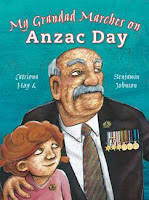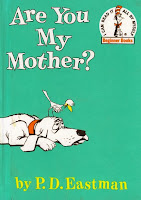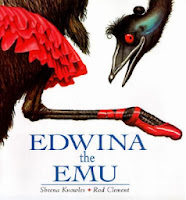John Schumann wrote an unforgettable song 'I Was Only 19' in 1983 with the band Redgum. It had the memorable refrain 'God help me, I was only 19'. The lyrics of this well-known Australian song have been brought to life in a children's picture book illustrated by the widely acclaimed Australian illustrator Craig Smith. The lyrics are used exactly as in the song and with Craig Smith's wonderful water colour and line drawings are a moving reminder of the Vietnam War. This was a war that was fought in different ways to the previous great wars and had less universal support than previous conflicts in which Australia and other nations had fought. This was a war that for many didn't seem 'quite real', and our servicemen still carry the physical and mental scars. The book is a moving insight into a war fought by young men who knew little about the country in which they fought and why they were there. It would be an ideal book to share with children aged 6-12 years as we approach ANZAC Day in Australia on April 25th.
2. 'Simpson and his Donkey' by Mark Greenwood & illustrated by Frané Lessac
Every Australian and English child who grew up in the 1950s to 70s in Australia would know of the story of Simpson and the donkey he used to retrieve wounded men on the WWI battlefields of the Gallipoli Peninsula in Turkey. This was one of the greatest of all defeats for the forces of Britain, France and of course the Australian and New Zealand armed forces (the ANZACs). In the midst of the massacre of thousands of allied troops and the eight-month siege of this isolated beachhead, a man and his donkey were responsible for saving many lives, before Simpson was eventually killed on yet another mission.
Mark Greenwood offers a moving story of John Simpson Kirkpatrick and how he and his donkey, Duffy, rescued over 300 men during the campaign at Gallipoli. It traces his life from his home in South Shields in Newcastle (England) and his journey from the Tyne Dock to Turkey. Informed by detailed research, the text includes a brief biography of the man, details of his work at Gallipoli and also the little known story of how one of the many he rescued was actually a childhood friend.
Frané Lessac's illustrations are a wonderful complement to the story and have strength of colour that is not controlled by conventions. There are skies of yellow, orange, aqua, purple and all shades of blue. Her unique style draws your eye deep into each plate; no details can easily be missed.
3. 'Do Not Forget Australia' by Sally Murphy
A poignant picture book about Henri, about France, about Billy and about Australia. It is based on the true story of how strong bonds are developed in the face of adversity.
Sally Murphy wrote the first draft of this special story on ANZAC Day, 2008, while her son was there in Villers-Bretonneux the place where Australian troops fought to save a French town in a foreign war. It took hr four years to complete, and the time spent on this special book shows.
4. 'My Grandad Marches on Anzac Day' (2006), illustrated by Benjamin Johnson
'My Grandad Marches on Anzac Day' was written by Catriona based on her children's grandfather who fought with the British army in World War II. It tells the story of one family's involvement in this day, but at the same time it is a similar story to that of many families who wake up early on the 25th April each year to remember the fallen of war and to celebrate the mateship of those who survive.
This book is an ideal way to help very young children learn something about Anzac Day. It is a simple, thoughtful and touching tale told through the eyes of a little girl. It explains what happens on the day and its significance for a young child.
I sit on Daddy’s shoulders.
It’s a very long wait.
But my grandad will come.
My grandad marches on Anzac Day. Teaching activities and notes for this books are available for teachers and parents HERE
5. 'Anzac Ted' by Belinda Landsberry (Exisle Publishing)
'Anzac Ted's a scary bear
and I can tell you why.
He's missing bits, his tummy splits,
he only has one eye'
That's how this beautifully illustrated book begins. A battered old teddy, that never wins a prize in the best toy competitions at school and frightens all the kids. But this bear has a secret. No one 'knows my Anzac's woes or just how brave he is.' Like the narrator's Grandpa, Anzac Ted is very old (100 this year in fact) and he made it through two wars as a mascot.
This is a lovely picture book for children aged 4-6 years that will allow very young children to access just as little of the Anzac legend.
6. 'One Minute's Silence' by David Metzenthen & illustrated by Michael Camilleri (Allen & Unwin)
This non-fiction, it is a moving and powerful
story about the meaning of Remembrance Day drawing on the ANZAC and
Turkish battle at Gallipoli. It is based on true events, but is written in a way that encourages the reader to imagine sprinting up the beach in
Gallipoli in 1915 with the fierce fighting Diggers. The reader is also encouraged to imagine
standing beside the brave battling Turks as they defended their
homeland from the cliffs above.
In the silence that follows a war long gone, the hope is that you might see what the soldiers saw, and feel a little of what the soldiers felt. And if you try, you might just be able to imagine the enemy, and see that he was not so different from 'his' enemy. The purpose is to challenge us to imagine, remember and honour soldiers on both sides of the conflict. All are heroes who shed their blood and lost their lives for their countries.
This is a very moving and powerful reflection on the meaning of Remembrance Day, which is brought to life by Michael Camilleri's incredible pencil drawings. Each double page spread is wonderful. One of my favourites is one that depicts the engineering, physics and impact of a bullet. I found this to be quite dramatic and challenging.
Readers aged 7-10 will enjoy this book.
7. 'The Poppy' by Andrew Plant
Stunningly illustrated in over 70 paintings, The Poppy is the true story of one of Australia's greatest victories, and of a promise kept for nearly a century. On Anzac Day, 1918, a desperate night counter-attack in the French village of Villers-Bretonneux became one of Australia's greatest victories. A bond was forged that night between France and Australia that has never been broken. Villers-Bretonneux is 'The town that never forgets'. What was achieved that terrible night - and what happened after - is a story that, likewise, Australians should never forget.
8. 'A Day to Remember' by Jackie French, illustrated by Mark Wilson
Anzac Day is the day when we remember and honour Anzac traditions down the ages, from the first faltering march of wounded veterans in 1916 to the ever increasing numbers of their descendants who march today. Containing reference to the many places the ANZACs have fought, and the various ways in which they keep the peace and support the civilians in war-torn parts of the world today, this is a picture book that looks not only at traditions, but also the effects of war.
9. 'Anzac Biscuits' by Phil Cummings
Phil Cummings adopts a dual narrative - each double page switches from Rachel and her mother in their kitchen, to Rachel's Dad who is fighting in the war - referred to as 'the soldier'.
Rachel and her mother busy themselves making ANZAC biscuits, in the kitchen. The language is light and fun filled describing their antics as they prepare their home cooked gift.
Each double page focusing on the soldier picks up on an element from the cosy kitchen - the crash and bang of pots and pans becomes the 'bang bang' of gunfire shots for the soldier. The warm smoke touched kitchen with its delicious aromas from the fireplace, becomes the 'choking smell' of 'angry guns'.
Cummings uses structure brilliantly here, this would be a great book to utilise in story crafting activities.

The poetic overtones to Cumming's language choices are a real highlight, and they are matched perfectly by Owen Swan's illustrations. The delicate soft lines reflect the tone of the narrative. They sweep the reader through the alternate scenes of the soldier, then the warm home.
ANZAC Biscuits is wonderful way to remember ANZAC Day, it offers many discussion points both relating to the subject of war and the use of language.
10. 'The Anzac Puppy' by Peter Millett
Inspired by true events, The Anzac Puppy demonstrates the strength dogs often provided soldiers during war. Freda, born during the war, became a good luck mascot for a soldier and his friends and inspired them to stay safe so they could honour a promise to bring the dog home.
11. 'Anzac Tale' by Ruth Starke and illustrated by Greg Holfield
When Australia pledges its support to Great Britain at the outbreak of World War I, mates Roy Martin and Wally Cardwell are among the first to enlist.
But what the friends first thought would be an adventure soon turns to disaster The day after the landing at Anzac Cove on 25 April 1915, more than 2000 of their fellow Anzacs are dead. As the campaign drags on, life for Wally and Roy and their new friend, Tom, becomes a battle of endurance against a plucky enemy, a hostile landscape, flies, fleas, cold and disease. The story of the Anzac campaign, including the battle of Lone Pine, is interspersed with scenes of Australians at home to show the shift from popular support of the Empire at the start of the war to profound disillusionment as the casualties begin to mount.
This is a wonderful book recommended by Justine who has used it with her class to great effect. The experiences of the soldiers landing at Anzac Cove are offered with animals filling the main characters roles of soldiers, officers, enemies and family at home. This is a different but powerful way to introduce children to this important story of courage, suffering and defeat.
Post modified 25th April 2015
Lest We Forget!


















































